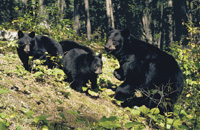Keep the "Wild" in Wildlife
National parks are great places to view wildlife in their natural habitat. However, once animals become accustomed to people, they are in danger of losing their "wildness". Habituated animals (those that have lost their natural fear of humans) can be dangerous because they appear docile and may come too close to humans. By acting responsibly, you can help ensure that future generations have an opportunity to see wildlife that is truly wild.
Please...
 Give wild animals space: stay at least 100 metres away
Give wild animals space: stay at least 100 metres away© Parks Canada / Lynn and Donna Rogers
Do not disturb wildlife. Give wild animals space (stay at least 100 metres away - approximately one football field), by not approaching too closely for a photograph or a better look. Bears, moose and other wildlife may react aggressively if they feel threatened by you or your pet.
Do not feed wildlife. It is illegal to feed wildlife in a national park. Wildlife find their healthiest food in their natural environment. Once they become accustomed to being fed by people, they stop looking for their natural foods and lose their fear of humans. These animals, no longer "wild", are a threat to public safety.
- Date modified :